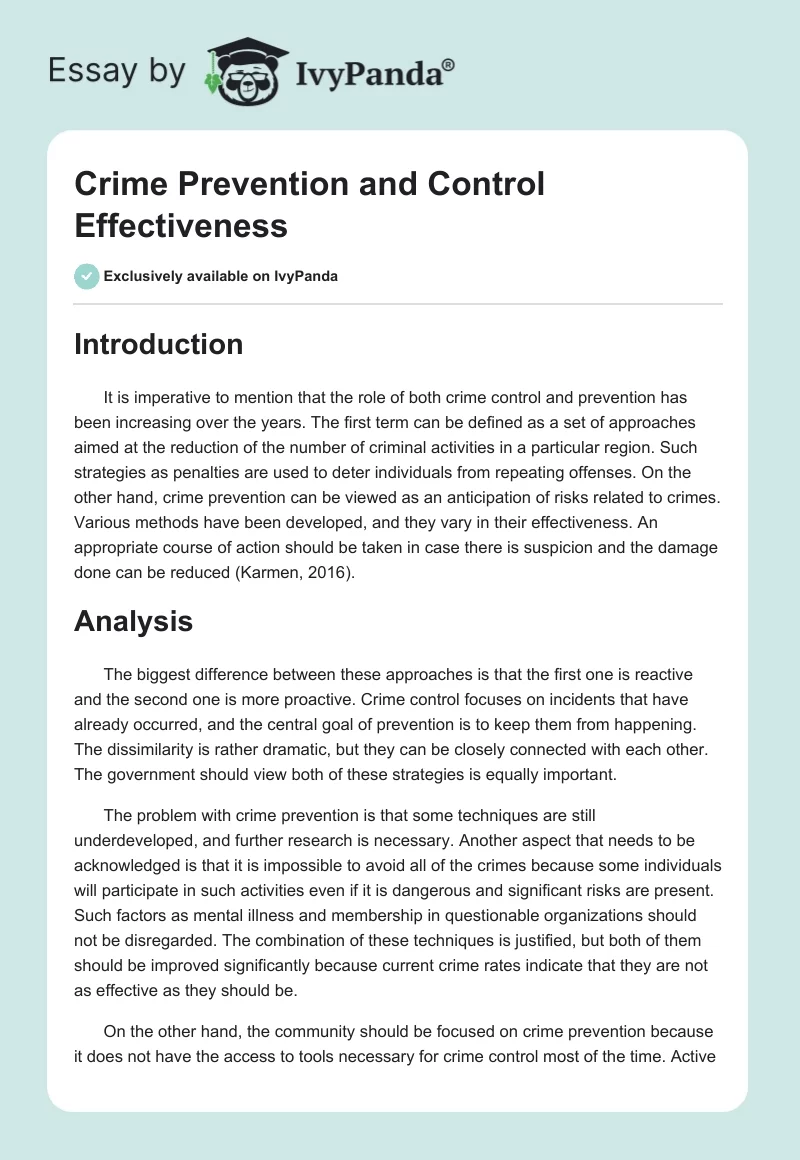Introduction
It is imperative to mention that the role of both crime control and prevention has been increasing over the years. The first term can be defined as a set of approaches aimed at the reduction of the number of criminal activities in a particular region. Such strategies as penalties are used to deter individuals from repeating offenses. On the other hand, crime prevention can be viewed as an anticipation of risks related to crimes. Various methods have been developed, and they vary in their effectiveness. An appropriate course of action should be taken in case there is suspicion and the damage done can be reduced (Karmen, 2016).
Analysis
The biggest difference between these approaches is that the first one is reactive and the second one is more proactive. Crime control focuses on incidents that have already occurred, and the central goal of prevention is to keep them from happening. The dissimilarity is rather dramatic, but they can be closely connected with each other. The government should view both of these strategies is equally important.
The problem with crime prevention is that some techniques are still underdeveloped, and further research is necessary. Another aspect that needs to be acknowledged is that it is impossible to avoid all of the crimes because some individuals will participate in such activities even if it is dangerous and significant risks are present. Such factors as mental illness and membership in questionable organizations should not be disregarded. The combination of these techniques is justified, but both of them should be improved significantly because current crime rates indicate that they are not as effective as they should be.
On the other hand, the community should be focused on crime prevention because it does not have the access to tools necessary for crime control most of the time. Active participation in such activities is incredibly important because an enormous percentage of crimes are preventable. The strategies should be reasonable and individuals must understand that it is necessary not to take advantage of powers. Risk management and avoidance of dangerous situations are incredibly important and should be considered by all members of the community. Having access to methods of self-defense is also vital.
Local government needs to conduct research focused on crime control, and only evidence-based approaches should be utilized. An increase in the number of surveillance cameras is also reasonable, and it is necessary to ensure that the quality of monitoring is high because it will help to reduce the number of crimes. Community policing also could be improved, and officers should utilize a variety of approaches to establish long-lasting relationships with citizens.
Moreover, it is important to avoid any bias and discrimination based on the color of skin. Racial profiling is not acceptable, and the approach needs to be eliminated. The community needs to be much more active when it comes to crime prevention, and it is appropriate to schedule meetings every week and discuss the techniques that may be used to avert crimes.
Conclusion
In summary, it is possible to state that the understanding of differences between these concepts is crucial, and helps to identify strategies that are more efficient depending on the situation. The progress that has been shown in this area is rather significant, but crimes still affect all the communities. Therefore, the focus on research and development of improved techniques is of utmost importance.
References
Karmen, A. (2016). Crime victims: An introduction to victimology (9th ed.). Boston, MA: Cengage Learning.


